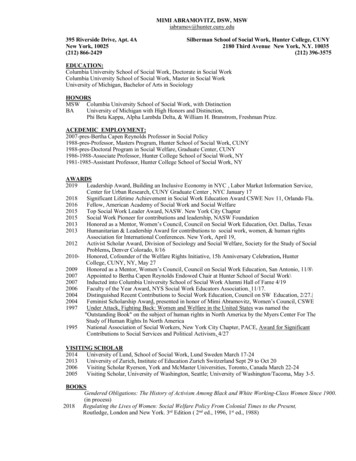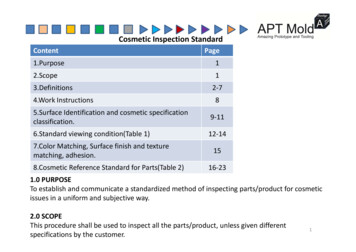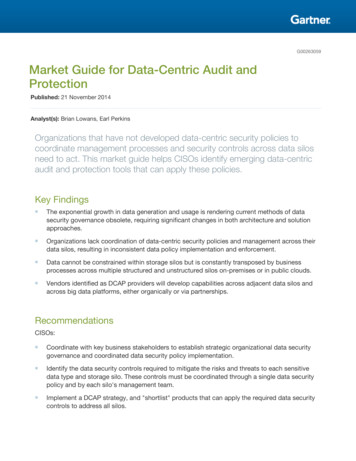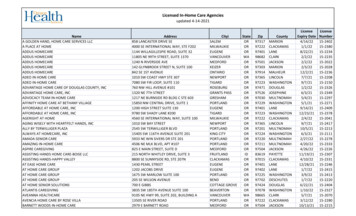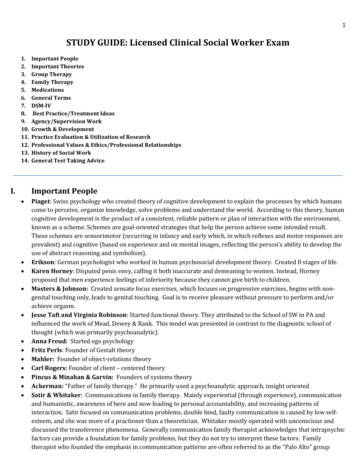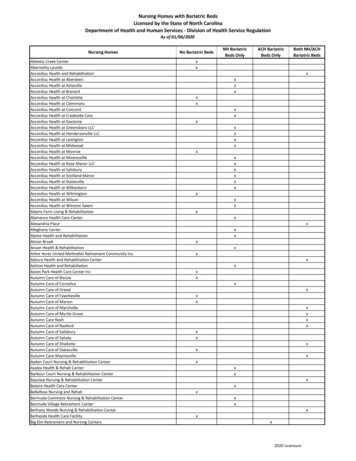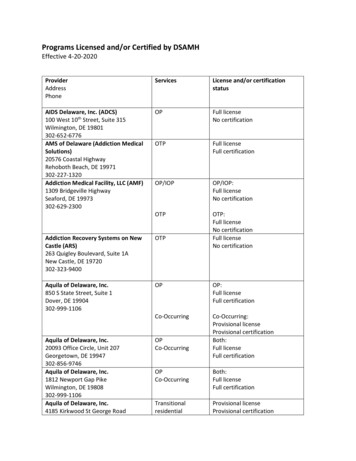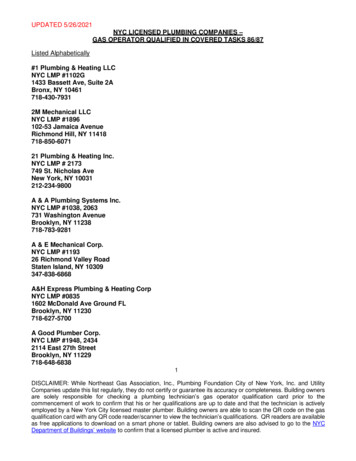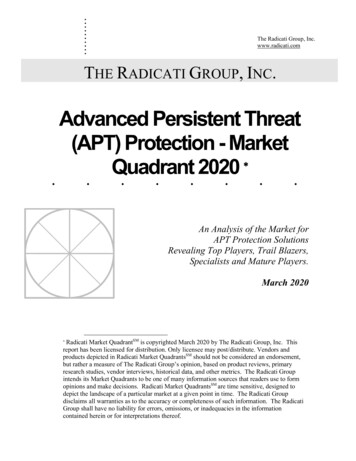
Transcription
.The Radicati Group, Inc.www.radicati.comTHE RADICATI GROUP, INC.Advanced Persistent Threat(APT) Protection - MarketQuadrant 2020 *.An Analysis of the Market forAPT Protection SolutionsRevealing Top Players, Trail Blazers,Specialists and Mature Players.March 2020Radicati Market QuadrantSM is copyrighted March 2020 by The Radicati Group, Inc. Thisreport has been licensed for distribution. Only licensee may post/distribute. Vendors andproducts depicted in Radicati Market QuadrantsSM should not be considered an endorsement,but rather a measure of The Radicati Group’s opinion, based on product reviews, primaryresearch studies, vendor interviews, historical data, and other metrics. The Radicati Groupintends its Market Quadrants to be one of many information sources that readers use to formopinions and make decisions. Radicati Market QuadrantsSM are time sensitive, designed todepict the landscape of a particular market at a given point in time. The Radicati Groupdisclaims all warranties as to the accuracy or completeness of such information. The RadicatiGroup shall have no liability for errors, omissions, or inadequacies in the informationcontained herein or for interpretations thereof.*
APT Protection - Market Quadrant 2020TABLE OF CONTENTSRADICATI MARKET QUADRANTS EXPLAINED . 3MARKET SEGMENTATION – ADVANCED PERSISTENT THREAT (APT) PROTECTION . 5EVALUATION CRITERIA . 7MARKET QUADRANT – APT PROTECTION . 10KEY MARKET QUADRANT HIGHLIGHTS . 11APT PROTECTION - VENDOR ANALYSIS . 11TOP PLAYERS . 11TRAIL BLAZERS . 27SPECIALISTS . 30MATURE PLAYERS . 47 This report has been licensed for distribution. Only licensee may post/distribute.Please contact us at admin@radicati.com if you wish to purchase a license. Copyright March 2020, The Radicati Group, Inc. Licensed for distribution.2
APT Protection - Market Quadrant 2020RADICATI MARKET QUADRANTS EXPLAINEDRadicati Market Quadrants are designed to illustrate how individual vendors fit within specifictechnology markets at any given point in time. All Radicati Market Quadrants are composed offour sections, as shown in the example quadrant (Figure 1).1. Top Players – These are the current market leaders with products that offer, bothbreadth and depth of functionality, as well as posses a solid vision for the future. TopPlayers shape the market with their technology and strategic vision. Vendors don’tbecome Top Players overnight. Most of the companies in this quadrant were firstSpecialists or Trail Blazers (some were both). As companies reach this stage, they mustfight complacency and continue to innovate.2. Trail Blazers – These vendors offer advanced, best of breed technology, in some areas oftheir solutions, but don’t necessarily have all the features and functionality that wouldposition them as Top Players. Trail Blazers, however, have the potential for “disrupting”the market with new technology or new delivery models. In time, these vendors are mostlikely to grow into Top Players.3. Specialists – This group is made up of two types of companies:a. Emerging players that are new to the industry and still have to develop someaspects of their solutions. These companies are still developing their strategy andtechnology.b. Established vendors that offer very good solutions for their customer base, andhave a loyal customer base that is totally satisfied with the functionality they aredeploying.4. Mature Players – These vendors are large, established vendors that may offer strongfeatures and functionality, but have slowed down innovation and are no longerconsidered “movers and shakers” in this market as they once were.a. In some cases, this is by design. If a vendor has made a strategic decision to movein a new direction, they may choose to slow development on existing products.Copyright March 2020, The Radicati Group, Inc. Licensed for distribution.3
APT Protection - Market Quadrant 2020b. In other cases, a vendor may simply have become complacent and be outdeveloped by hungrier, more innovative Trail Blazers or Top Players.c. Companies in this stage will either find new life, reviving their R&D efforts andmove back into the Top Players segment, or else they slowly fade away as legacytechnology.Figure 1, below, shows a sample Radicati Market Quadrant. As a vendor continues to develop itsproduct solutions adding features and functionality, it will move vertically along the “y”functionality axis.The horizontal “x” strategic vision axis reflects a vendor’s understanding of the market and theirstrategic direction plans. It is common for vendors to move in the quadrant, as their productsevolve and market needs change.HighRadicati Market QuadrantSMMature PlayersTop Players Company LFunctionality Company Z Company Y Company J Company HLow Company D Company BCompany CCompany ASpecialistsLow Company E Company FCompany GTrail BlazersStrategic VisionHighFigure 1: Sample Radicati Market QuadrantINCLUSION CRITERIAWe include vendors based on the number of customer inquiries we receive throughout the year.We normally try to cap the number of vendors we include to about 10-12 vendors. Sometimes,however, in highly crowded markets we need to include a larger number of vendors.Copyright March 2020, The Radicati Group, Inc. Licensed for distribution.4
APT Protection - Market Quadrant 2020MARKET SEGMENTATION – ADVANCED PERSISTENT THREAT (APT) PROTECTIONThis edition of Radicati Market QuadrantsSM covers the “Advanced Persistent Threat (APT)Protection” segment of the Security Market, which is defined as follows: Advanced Persistent Threat Protection – are a set of integrated solutions for thedetection, prevention and possible remediation of zero-day threats and persistentmalicious attacks. APT solutions may include but are not limited to: sandboxing, EDR,CASB, reputation networks, threat intelligence management and reporting, forensicanalysis and more. Some of the leading players in this market are Cisco, ESET, FireEye,Forcepoint, Fortinet, Kaspersky, McAfee, Microsoft, Palo Alto Networks, Sophos,Symantec, and VMware Carbon Black. This report only looks at vendor APT protection solutions aimed at the needs of enterprisebusinesses. It does not include solutions that target primarily service providers (i.e. carriers,ISPs, etc.). APT protection solutions can be deployed in multiple form factors, including software,appliances (physical or virtual), private or public cloud, and hybrid models. Virtualizationand hybrid solutions are increasingly available through most APT security vendors. APT solutions are seeing rapid adoption across organization of all business sizes and industrysegments, as all organizations are increasingly concerned about zero-day threats and highlytargeted malicious attacks. The worldwide revenue for APT Protection solutions is expected to grow from nearly 5.2billion in 2020, to over 10.5 billion by 2024.Copyright March 2020, The Radicati Group, Inc. Licensed for distribution.5
APT Protection - Market Quadrant 2020APT Protection - Revenue Forecast, 2020-2024 12,000 10,598 10,000 8,831 7,359 8,000 6,184 6,000 5,197 4,000 2,000 020202021202220232024Figure 2: APT Protection Market Revenue Forecast, 2020 – 2024Copyright March 2020, The Radicati Group, Inc. Licensed for distribution.6
APT Protection - Market Quadrant 2020EVALUATION CRITERIAVendors are positioned in the quadrant according to two criteria: Functionality and StrategicVision.Functionality is assessed based on the breadth and depth of features of each vendor’s solution.All features and functionality do not necessarily have to be the vendor’s own originaltechnology, but they should be integrated and available for deployment when the solution ispurchased.Strategic Vision refers to the vendor’s strategic direction, which comprises: a thoroughunderstanding of customer needs, ability to deliver through attractive pricing and channelmodels, solid customer support, and strong on-going innovation.Vendors in the APT Protection space are evaluated according to the following key features andcapabilities: Deployment Options – availability of the solution in different form factors, such as onpremises solutions, cloud-based services, hybrid, appliances and/or virtual appliances. Platform Support – support for threat protection across a variety of platforms including:Windows, macOS, Linux, iOS, and Android. Malware detection – usually based on behavior analysis, reputation filtering, advancedheuristics, and more. Firewall & URL – filtering for attack behavior analysis. Web and Email Security – serve to block malware that originates from Web browsing oremails with malicious intent. SSL scanning – traffic over an SSL connection is also commonly monitored to enforcecorporate policies. Encrypted traffic analysis – provides monitoring of behavior of encrypted traffic to detectpotential attacks.Copyright March 2020, The Radicati Group, Inc. Licensed for distribution.7
APT Protection - Market Quadrant 2020 Forensics and Analysis of zero-day and advanced threats – provide heuristics and behavioranalysis to detect advanced and zero-day attacks. Sandboxing and Quarantining – offer detection and isolation of potential threats. Endpoint Detection and Response (EDR) – is the ability to continuously monitor endpointsand network events, in order to detect internal or external attacks and enable rapid response.EDR systems feed information into a centralized database where it can be further analyzedand combined with advanced threat intelligence feeds for a full understanding of emergingthreats. Some EDR systems also integrate with sandboxing technologies for real-time threatemulation. Most EDR systems integrate with forensic solutions for deeper attack analysis. Directory Integration – integration with Active Directory or LDAP, to help manage andenforce user policies. Cloud Access Security Broker (CASB) – are on-premises or cloud-based solutions that sitbetween users and cloud applications to monitor all cloud activity and enforce securitypolicies. CASB solutions can monitor user activity, enforce security policies and detecthazardous behavior, thus extending an organization’s security policies to cloud services. Data Loss Prevention (DLP) – allows organizations to define policies to prevent loss ofsensitive electronic information. Mobile Device Protection – the inclusion of Mobile Device Management (MDM) orEnterprise Mobility Management (EMM) features to help protect mobile endpoints. Administration – easy, single pane of glass management across all users and networkresources. Real-time updates – to rapidly block, quarantine and defend against newly identified threatsor attacks across all network resources. Environment threat analysis – to detect existing threat exposure and potential threat sources. Remediation – refers to the ability to contain incidents, automatically remove malware, andrestore endpoints and all affected resources to a pre-incident working state, as well as theCopyright March 2020, The Radicati Group, Inc. Licensed for distribution.8
APT Protection - Market Quadrant 2020ability to issue software updates. Many vendors define remediation as just blocking and/orquarantining threats without re-imaging of compromised devices. While this is an importantfirst step, it is not sufficient and remediation should also include re-imaging or restoring alldevices to their pre-compromised state, or at least the provision of workflows and integrationwith tools and mechanisms to achieve that.In addition, for all vendors we consider the following aspects: Pricing – what is the pricing model for their solution, is it easy to understand and allowscustomers to budget properly for the solution, as well as is it in line with the level offunctionality being offered, and does it represent a “good value”. Customer Support – is customer support adequate and in line with customer needs andresponse requirements. Professional Services – does the vendor provide the right level of professional services forplanning, design and deployment, either through their own internal teams, or throughpartners.Note: On occasion, we may place a vendor in the Top Player or Trail Blazer category even ifthey are missing one or more features listed above, if we feel that some other aspect(s) of theirsolution is particularly unique and innovative.Copyright March 2020, The Radicati Group, Inc. Licensed for distribution.9
APT Protection - Market Quadrant 2020MARKET QUADRANT – APT PROTECTIONRadicati Market QuadrantSMHighMature PlayersTop PlayersSymantec Cisco McAfee Kaspersky FunctionalityESET Fortinet Sophos Forcepoint FireEye Carbon Black Microsoft Palo Alto Networks LowSpecialistsLowTrail BlazersStrategic VisionHighFigure 3: APT Protection Market Quadrant, 2020**Radicati Market QuadrantSM is copyrighted March 2020 by The Radicati Group, Inc. This report hasbeen licensed for distribution. Only licensee may post/distribute. Vendors and products depicted inRadicati Market QuadrantsSM should not be considered an endorsement, but rather a measure of TheRadicati Group’s opinion, based on product reviews, primary research studies, vendor interviews,historical data, and other metrics. The Radicati Group intends its Market Quadrants to be one ofmany information sources that readers use to form opinions and make decisions. Radicati MarketQuadrantsSM are time sensitive, designed to depict the landscape of a particular market at a givenpoint in time. The Radicati Group disclaims all warranties as to the accuracy or completeness of suchinformation. The Radicati Group shall have no liability for errors, omissions, or inadequacies in theinformation contained herein or for interpretations thereof.Copyright March 2020, The Radicati Group, Inc. Licensed for distribution.10
APT Protection - Market Quadrant 2020KEY MARKET QUADRANT HIGHLIGHTS The Top Players in the market are Symantec, Cisco, Kaspersky, and ESET. The Trail Blazers quadrant includes Sophos. The Specialists quadrant includes Fortinet, Forcepoint, FireEye, VMware Carbon Black,Microsoft, and Palo Alto Networks. The Mature Players quadrant includes McAfee.APT PROTECTION - VENDOR ANALYSISTOP PLAYERSSYMANTEC, A DIVISION OF BROADCOM1320 Ridder Park DriveSan Jose, CA 95131www.symantec.comFounded in 1982, Symantec has grown to be one of the largest providers of enterprise securitytechnology. Symantec’s security solutions are powered by its Global Intelligence Network, whichoffers real-time threat intelligence. Symantec is a division of Broadcom, a publicly traded company.SOLUTIONSSymantec provides on-premises, hybrid and cloud-based solutions for advanced threat protection tosafeguard against advanced persistent threats and targeted attacks, detect both known and unknownmalware, and automate the containment and resolution of incidents. Symantec’s security portfoliocomprises the following components: Symantec Endpoint Security Complete (SESC) – is Symantec’s new endpoint securityoffering which provides full endpoint protection, including anti-malware, formerly deliveredCopyright March 2020, The Radicati Group, Inc. Licensed for distribution.11
APT Protection - Market Quadrant 2020by Symantec Endpoint Protection (SEP), plus Endpoint Detection and Response (EDR)capabilities in a single package. SESC exposes advanced attacks through machine learningand global threat intelligence. It utilizes advanced attack detections at the endpoint andcloud-based analytics to detect targeted attacks such as breach detection, command andcontrol beaconing, lateral movement and suspicious power shell executions. It allowsincident responders to quickly search, identify and contain all impacted endpoints whileinvestigating threats using a choice of on-premises and cloud-based sandboxing. In addition,continuous and on-demand recording of system activity supports full endpoint visibility.SESC also includes application control, breach detection, application isolation, breachassessment, and Active Directory defense. Symantec Email Threat Detection and Response (TDR) – protects against email-borne targetedattacks and advanced threats, such as spear-phishing. It leverages a cloud-based sandbox anddetonation capability and Symantec Email Security.cloud to expose threat data from maliciousemails. Email TDR sends events to Symantec EDR for correlation with endpoint and networkevents. Symantec Critical Attack Discovery and Intelligence (CADI) – utilizes rich telemetry,cyber-attack experience, and machine learning (ML) to hunt for and discover high-fidelityincidents, alerting customers and identifying the tactics, techniques and procedures (TTPs)used by adversaries. This capability is delivered as an integral part of SESC. Symantec Threat Hunting Center (STHC) – automates threat hunting and uses anintelligence-driven workflow that associates indicators with threat models (actors, threatbulletins, campaigns, TTP, and vulnerabilities) using integrated threat intelligence from opensource, commercial, and Symantec intelligence and matches observables with indicators.STHC is able to apply millions of indicators to billions of events and perform retrospectiveanalysis in seconds. It connects to SIEM solutions (e.g. Splunk, Qradar, ArcSight, andothers) to help automate threat hunting. Symantec ProxySG appliance, Secure Web Gateway Virtual Appliance, or Cloud delivered WebSecurity Service – are solutions that serve to block known threats, malicious sources, risky sites,unknown content categories, and malware delivery networks at the gateway in real-time.Symantec Content Analysis integrates with the ProxySG appliance to orchestrate malwarescanning and application blacklisting, while Symantec SSL Visibility provides additionalvisibility into SSL/TLS encrypted threats across network security appliances, including third-Copyright March 2020, The Radicati Group, Inc. Licensed for distribution.12
APT Protection - Market Quadrant 2020party tools. Symantec Web Isolation also integrates with ProxySG Appliances and Cloud Serviceto protect end-users from zero day, unknown and risky sites by executing code, and potentialmalware, from websites remotely. Symantec Content Analysis – analyzes and mitigates unknown content by automaticallyinspecting files from ProxySG, Symantec Messaging Gateway, Symantec Endpoint Protection orother sources using multiple layers of inspection technology (reputation, dual anti-malwareengines, static code analysis, advanced machine learning, and more). It then brokers suspiciouscontent to the Symantec sandbox or other sandboxes. Content Analysis is available as an onpremises, hybrid or cloud-hosted solution. Intelligence is shared through the Symantec GlobalIntelligence Network, providing enhanced protection across the entire security infrastructure. Symantec Web Isolation – executes web sessions away from endpoints, sending only saferendering o
Kaspersky Web Traffic Security (KWTS) – delivers web-based threat protection and provides an automated response based on in-depth KATA Platform detections. Kaspersky Threat Intelligence Portal – offers a single access point to threat intelligence, avail

